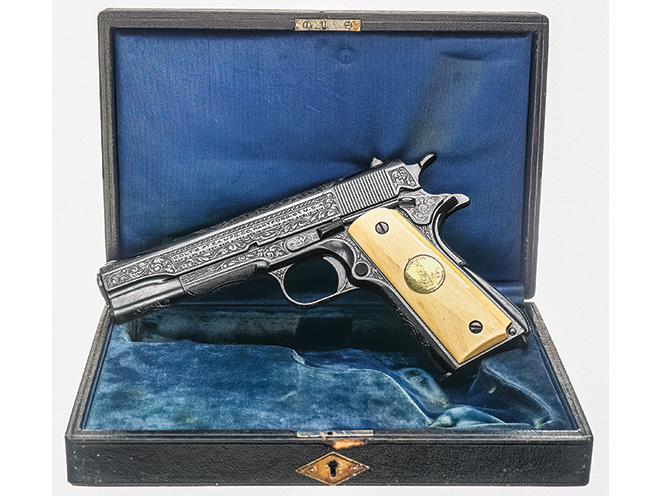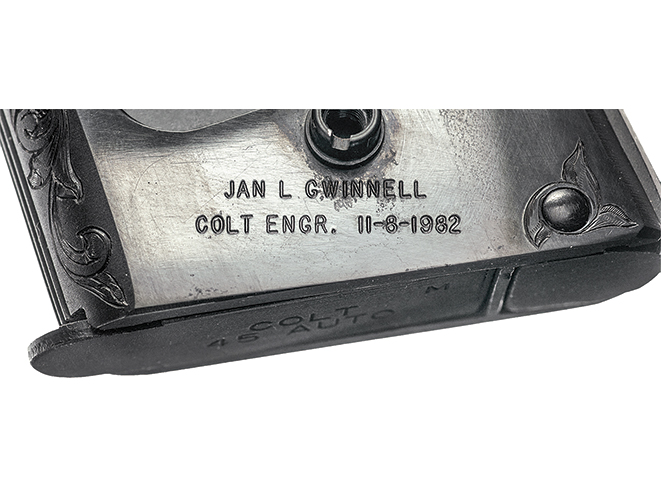In the 19th century, gun engraving was of paramount importance to Samuel Colt, not only as an art form, but also for its value in promoting his first arms-making venture, the Patent Arms Manufacturing Company in Paterson, New Jersey. Many of Colt’s earliest Paterson pistols were lavishly hand-engraved presentations, as Colt firmly believed that an engraved firearm was one of the finest gifts a man could receiver from his peers.
Indeed, history had proven that to be true long before Colt received his first revolver patent in 1835. In fact, the use of engraved presentation arms had been flourishing since the early 17th century when European nobles made the gifting of highly embellished flintlock pistols and long arms a fashionable form of détente. Colt used engraved guns much the same way, and to great advantage throughout his career, by presenting handsomely engraved pistols and revolving rifles to U.S. military leaders, politicians and foreign heads of state.
It is estimated that between 1836 and 1862 (the year that Samuel Colt passed away at the age of 48), he had presented more than 1,500 Colt handguns and long arms to foreign leaders, high-ranking U.S. military officers and key personnel within the U.S. government. On the heels of such largess, Samuel Colt became one of the world’s most successful arms-makers. He was also generous with the presentation of engraved guns to his senior employees and family. The Colt company continued that tradition to some extent long after Samuel Colt passed on. The company maintained one of the finest in-house gun engraving shops in the world headed by some of the greatest artisans of the 19th and 20th centuries, master craftsmen who turned mere steel weapons into timeless pieces of art.
Advertisement — Continue Reading Below
Vines & Scrolls

The traditional engraving patterns dating back to Colt’s 19th century masters have survived more than 180 years, with many of the most desirable created by Richard Henshaw (principal engraver for Colt from 1835 to 1842), Gustave Young and his successor, Cuno A. Helfricht, at the Colt factory in Hartford, Connecticut.
RELATED STORY: 13 Iconic Combat Handguns Throughout History
Advertisement — Continue Reading Below
Among Young and Helfricht’s most enduring styles were the prolific use of vine scrolls, leaf designs and variations such as the popular bank note scroll, all of which were to become hallmarks of both the Young and Helfricht shops at Colt. Their deluxe presentation models often had engraved screw heads as well—a little something extra that was not generally done in standard engraving. The addition of animals and symbols within the scrollwork (established by Young), punch-dot backgrounds and gold inlay was another trait of their finest work for Colt.
Gustave Young and his shop produced engraved guns for Colt from 1852 through 1869. In the late 1850s, Young was joined by Charles J. Helfricht and his son Cuno, who was only 20 years old at the time. Cuno followed in his father’s footsteps as a contract engraver for Colt with more work coming his way in 1869, when Young departed Hartford and moved his family and shop to Springfield, Massachusetts, to establish his own independent firearms-engraving business. Cuno Helfricht would soon rise to the position of Colt’s chief engraver, a post he held from 1871 to 1921. And that means he engraved the earliest examples of the Colt Model 1911.

Helfricht was joined in 1919 by other legendary engravers: Wilber A. Glahn, who remained with Colt until 1950, and Rudolph Kornbrath, who worked as a factory engraver from 1919 to 1940, along with W.H. Gough. Today their early, documented, factory-engraved 1911s are among the most prized examples, with prices hovering anywhere from $50,000 to $85,000.
Advertisement — Continue Reading Below
RELATED STORY: Making History – GLOCK Pistols at the Cody Firearms Museum
The evolution of Colt 1911 engraving styles actually began with the Model 1905, the original .45 ACP model. Only six pistols were factory engraved in the series before the 1905 was replaced in 1911 by the new Government Model 1911. According to Colt historian R.L. Wilson, approximately 140 Colt Model 1911 and 1911A1 pre-WWII pistols were factory engraved, and of that number, seven are known to have been gold inlaid. The style of engraving, in keeping with the Helfricht shop, featured scroll and border work. The best models from the factory engravers often had the top and sides of the slide covered with deeply cut and skillfully executed scrollwork. The sides of the frame, the bottom of the trigger-guard, the bottom of the grip and the mainspring housing were also decorated in a similar scroll pattern. Both the slide stop and safety lock could have light engraving as well, and the edges of the frame above and behind the trigger were finely checkered. The most highly engraved 1911 examples were the Colt National Match .45s produced from 1933 through 1941. Approximately 25 were done with almost full coverage, with three known to have also been gold inlaid. The engraving style was again traditional scrollwork with borders.
Into World War II
Advertisement — Continue Reading Below

Interestingly, Model 1911A1 engraving was extremely rare during WWII and did not emerge again as a popular option until the early postwar era. Today, postwar examples and later Series 70 National Match pistols (1970-1983) still command up to $15,000.
RELATED STORY: General Officer’s Pistols – Colt Pocket Hammerless Model 1903 & 1908
Over the decades since the end of WWII, and throughout the 1911’s 105-year history, the factory engraving department (which became the Colt Custom Shop), has continued the traditions established by Helfricht, Glahn and Kornbrath. They were succeeded by Alvin F. Herbert from 1956 to 1968 and then A.A. White and his company of engravers. Many of the finest examples known today were done from the 1970s to the 1990s by Alvin A. White, his protégé Andrew Bourbon, the legendary Winston Churchill and Howard Dove, John J. Adams, Sr., Ken Hurst, Denise Thirion, Leonard Francolini, Bob Bert, K.C. Hunt and recently retired Colt factory head of engraving George Spring.
Advertisement — Continue Reading Below
Today, the Colt Custom Shop has a list of remarkable gun engravers headed by Jan Gwinnel and Steve Kamyk, and contract factory engravers that still include John J. Adams, Sr., and his son John J. Adams, Jr., all carrying on a tradition established in the very early 20th century by Helfricht, Glahn and Kornbrath. It seems that the art of 1911 engraving, like the Colt Model 1911 itself, has also remained timeless.
This article was published in the 2016 edition of the Complete Book of 1911s. For information on how to subscribe, please email subscriptions@




































